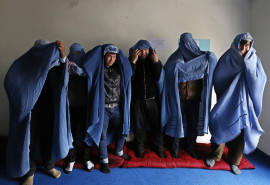
They lose their fathers, husbands, sons and brothers in acts of terrorism and violence. They themselves are injured and killed. Yet, the women of Pakistan do not have a voice in the peace processes in the country. They are stakeholders and direct effectees of terrorism but have no say in how it should be handled. If there is one thing that glared out at the (in)famous All-Parties Conference (APC) post the Army Public School attack, it was this: there were no women present. With the exception of perhaps, Sherry Rehman, women have hardly ever been included in the most important discussions in the country. As we gear to celebrate the International Women’s Day tomorrow, it remains a bitter truth that Pakistan’s women are considered good enough for things that we call ‘fluff’. They have a voice in health, education and other developmental issues. But there is a deafening and forced silence when it comes to their perspective on peace-building and conflict resolution strategies at all tiers, whether it is the aman jirgas or the National Action Plan (NAP).
In the year 2000, the UN Security Council resolution (UNSCR) 1325 on women, peace and security was adopted. This resolution recognises the need to increase women’s role in peace-building in conflict-ridden countries. However, the scope of 1325 is much wider. It not only calls for women to be included in peace talks, it also presses for a more gender-sensitive perspective to consider the special needs of women and girls during conflict, repatriation, rehabilitation, reintegration and post-conflict reconstruction. The UNSCR 1325 focuses on issues of gender-based violence and refugee camps covered in Articles 10 and 12. Thus, the impact gets wider. Post the October 2005 earthquake and the 2010 floods, to name two natural disasters in Pakistan that caused massive damage and human displacement, women trafficking increased.
Since 2000, 48 countries have adopted NAPs on Resolution 1325 to make policies to fulfill the resolution’s objectives. Developing and conflict-affected countries use NAPs to support women’s participation in politics and peace processes, as well as commitments on protection from sexual and gender-based violence. Yet a less than one-fourth of UN member states have implemented these NAPs.
Pakistan has not implemented 1325. Neither has India. It is rather curious that a resolution is unanimously hailed as a step in the right direction, yet is not implemented by the government. While many activists and proponents of women’s rights in Pakistan agree in spirit with 1325, it is not without reservations. The human rights’ camp remains discretely divided over the issue. And the reason is simple. Accepting a UN Security Council resolution comes with its share of possible consequences — consequences in the form of the proverbial ‘boots’ and sanctions. Many feel that such resolutions have other ‘agenda’, which is why Pakistan, among many other countries, remains sceptical of it. Other peace and gender activists strongly assert that Pakistan has no national action plan on 1325 not just because it is afraid of sanctions but because the much-needed political will is missing. These activists regularly urge the government to implement 1325.
The reasons can be debated. But the fact remains that across the globe, from 1992 to 2011, only four per cent of signatories to peace agreements and nine per cent of negotiators at peace tables were women. In Pakistan, the numbers would be even lower. The pandemic of violence against women and girls affects one in three women worldwide, and conflict zones are the worst hit. This correlation is often missed out.
Perhaps, a less controversial and more effective way would be to go via the CEDAW Committee’s landmark General Recommendation (GR 30) on Women in Conflict Prevention, Conflict and Post-Conflict Situations. This was adopted on October 18, 2013. Pacifist and more realistic voices from the civil society feel that implementing GR 30 could also have the desired results. But even if these resolutions and recommendations are implemented, will the Pakistani woman at the grassroots level have a say, alongside the men, regarding how peace should be achieved? It is time this conversation starts, and a narrative around this is built.
Published in The Express Tribune, March 7th, 2015.
Like Opinion & Editorial on Facebook, follow @ETOpEd on Twitter to receive all updates on all our daily pieces.
















































COMMENTS (3)
Comments are moderated and generally will be posted if they are on-topic and not abusive.
For more information, please see our Comments FAQ